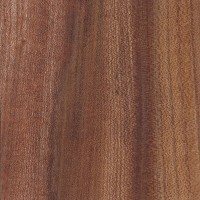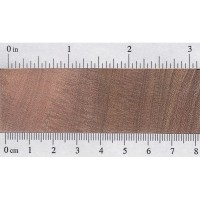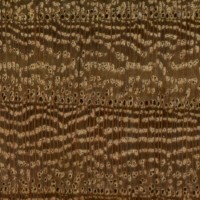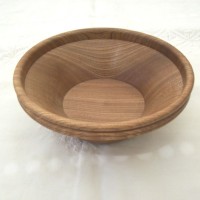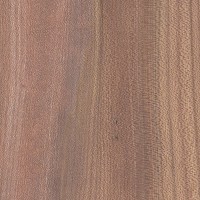 |
Common Name(s): Wych Elm, Scots Elm Scientific Name: Ulmus glabra Distribution: Europe Tree Size: 65-100 ft (20-30 m) tall, 2-4 ft (.6-1.2 m) trunk diameter Average Dried Weight: 38 lbs/ft3 (605 kg/m3) Specific Gravity (Basic, 12% MC): .49, .61 Janka Hardness: 990 lbf (4,400 N) Modulus of Rupture: 14,240 lbf/in2 (98.2 MPa) Elastic Modulus: 1,615,000 lbf/in2 (11.14 GPa) Crushing Strength: 6,710 lbf/in2 (46.3 MPa) Shrinkage: Tangential: 12.4% |
Color/Appearance: Heartwood is light to medium reddish brown. Paler sapwood is usually well defined.
Grain/Texture: Grain is interlocked (making it very resistant to splitting). With a somewhat coarse, uneven texture.
Endgrain: Ring-porous; medium to large earlywood pores in a continuous row one or two pores wide, small latewood pores in wavy bands; tyloses occasionally present in earlywood; growth rings distinct; rays not visible without lens; parenchyma vasicentric and confluent.
Rot Resistance: Rated as non-durable; susceptible to insect attack. Living trees are susceptible to Dutch elm disease.
Workability: Can be a challenge to work because of interlocked grain, especially on quartersawn surfaces. Planing can cause tearout and/or fuzzy surfaces. Poor dimensional stability. Glues, stains, and finishes well. Responds well to steam bending, and holds nails and screws well.
Odor: Elm usually has a strong, unpleasant smell when green; though once dried has very little odor.
Allergies/Toxicity: Although severe reactions are quite uncommon, Elm in the Ulmus genus has been reported as a sensitizer. Usually most common reactions simply include eye and skin irritation. See the articles Wood Allergies and Toxicity and Wood Dust Safety for more information.
Pricing/Availability: Should be moderately priced within its natural habitat in Europe, though availability from mature trees has been greatly diminished by Dutch elm disease.
Sustainability: This wood species is not listed in the CITES Appendices or on the IUCN Red List of Threatened Species.
Common Uses: Boxes, baskets, furniture, hockey sticks, veneer, wood pulp, and papermaking.
Comments: Elm trees are commonly infected with Dutch elm disease, a fungal disease spread by elm bark beetles. D.E.D. has wiped out millions of Elm trees worldwide.
Scans/Pictures: A special thanks to Steve Earis for providing the wood sample and turned photo of this wood species.


